2. 青海大学地质工程系, 西宁 810016
2. Department Geological and Engineering, Qinghai University, Xining 810016, China
滇西三江地区处于古冈瓦纳和欧亚两个超级大陆的汇聚带,从古生代到新生代期间,经历了古-中-新特提斯洋开启-扩张-消减-闭合的过程及后来的印度-欧亚大陆碰撞过程(邓军等, 2011, 2012; 邓军,2016;Metcalfe, 2002; Deng et al., 2014a, b; Wang et al., 2017)。三江地区由多个微地块拼贴而成,包括兰坪-思茅、保山、腾冲等3个地块以及分布其间的怒江断裂带、昌宁-孟连断裂带和金沙江-哀牢山断裂带(莫宣学等, 1993; 钟大赉, 1998; 李兴振等, 2002; Metcalfe, 2013)。滇西三江地区岩浆活动频繁,岩石类型多样,区内广泛分布早古生代-新生代岩浆岩(陈吉琛等, 1991; 吕伯西等, 1993; 莫宣学等, 1993; 董方浏等, 2006; Liang et al., 2008; Xu et al., 2012; Dong et al., 2013; Wang et al., 2014b, 2018)。研究表明,花岗岩地球化学组分及侵位年龄现在能够精准的测定,因此可以用反映壳-幔相互作用的花岗岩揭示陆壳时空演化的性质和格架(Zhu et al., 2011; Ping et al., 2013)。由于腾冲地块三叠纪构造属性不清,晚三叠世花岗岩侵位年龄、岩石成因类型、源区性质等问题需要解决,需要进一步研究提供依据。
腾冲地块是西南三江特提斯造山带的重要组成部分,Metcalfe(2006, 2011)认为腾冲地块归属于滇缅马苏(Sibumasu)地块;而有的学者认为腾冲地块是拉萨地块的东延部分(Wopfner 1996; Shi et al., 2008; Wopfner et al., 2009; Metcalfe et al., 2014),这是腾冲地块的归属目前存在两种主要认识。另外,中生代花岗岩做为特提斯洋在腾冲地块发展演化的历史记录,一直是研究热点。本文拟结合腾冲地块梁河地区花岗岩锆石年龄及Hf同位素数据,揭示梁河晚三叠世正长花岗岩的地质年代格架、岩石成因类型、探讨花岗岩熔浆源区,推测其构造背景,进一步制约其构造演化过程。
1 地质背景和样品腾冲地块位于西南三江特提斯造山带西南端、东喜马拉雅构造结的南侧翼,东以怒江-瑞丽断裂带与保山地块为邻,西以密支那缝合带与西缅地块相接,东西宽仅~70km,南北仅~120km(Hou et al., 2007; Searle et al., 2007; Xu et al., 2012; 邓军等, 2011, 2016, 邓军,2016; Deng et al., 2014a, b, 2017a, b; Chen et al., 2017)(图 1a)。腾冲和保山地块三叠纪时期位于昌宁-孟连洋封闭时的前陆部位,在晚三叠世腾冲地块和保山地块之间形成班公湖-怒江东延分支海槽,并在侏罗纪闭合,形成高黎贡山碰撞带(钟大赉, 1998)。
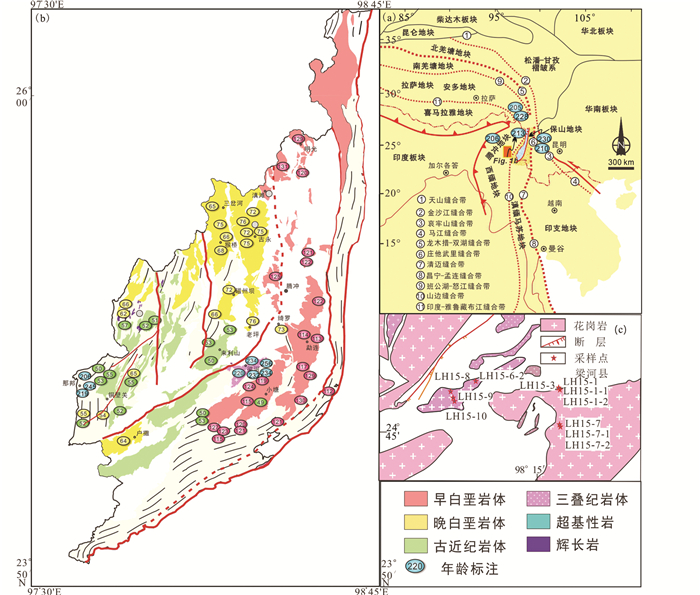
|
图 1 研究区地质背景图 (a)青藏高原和滇西地区大地构造简图(据Xu et al., 2012; Wang et al., 2016修改);(b)腾冲地块中-新生代岩浆分布图(据Deng et al., 2014b; Wang et al., 2014a修改);年龄数据参考Xie et al., 2016; 禹丽, 2016; 董美玲, 2016;(c)研究区采样位置图(据云南省地质局区域地质调查队,1982①) Fig. 1 Geological background of the study area |
① 云南省地质局区域地质调查队.1982.中华人民共和国矿产图腾冲幅(G-47-ⅩⅩⅤⅡ)
腾冲地块梁河地区地层发育较全,主要有早元古宙变质基底,主要组成岩性为变粒岩、片麻岩、条带状混合岩,这一时期岩性有绿片岩相变形特征;晚古生代长石石英砂岩、含长石岩屑石英砂岩、白云质灰岩和灰岩;中生代基性超基性岩及新生代花岗岩、玄武质火山岩组成。区内花岗岩产在早元古宙变质基底中,呈带状分布。花岗岩的侵入使中石炭统岩石发生热变质(禹丽, 2016)。
腾冲地块发生多期岩浆事件,形成了大批与花岗岩有关的Sn、Fe和稀有金属矿床。早白垩世发育矽卡岩型Fe多金属和Sn矿床(Chen et al., 2014; Cao et al., 2014);晚白垩世发育云英岩型、矽卡岩型大松坡-小龙河超大型和新岐大型Sn-稀有金属矿床(Chen et al., 2014; Deng et al., 2014b; Cao et al., 2016);古近纪有来利山大型Sn矿床(Chen et al., 2014; Deng et al., 2014b)。
腾冲地块岩浆活动频繁,发育有不同时代花岗岩(图 1b)。主要有高黎贡早古生代岩浆岩带(500~460Ma)(Zhao et al., 2016; Wang et al., 2013; Eroğlu et al., 2013; 李再会等, 2012);明光-勐连-梁河早白垩世岩浆岩带(128~108Ma)(Xie et al., 2016; Zhu et al., 2015; Zhao et al., 2016; Eroğlu et al., 2013; 罗改等, 2012; Cong et al., 2011; 白宪洲等, 2012);三岔河-古永-新岐-磁洲坝晚白垩世岩浆岩带(75~65Ma)(Xu et al., 2012; Qi et al., 2015; Chen et al., 2015; Zhao et al., 2017);来利山-盈江-那邦-铜壁关古近纪岩浆岩带(56~51Ma)。同时还有三叠纪岩浆岩,但有关三叠纪花岗岩研究较少,需要进一步研究三叠纪岩浆的起源、岩石成因类型,进一点制约古特提洋的构造演化过程。
本次研究区位于腾冲地块梁河地区,花岗岩分布广泛,简称腾梁花岗岩。本文样品采自梁河县西南处(图 1c),样品地理坐标为N24°47.213'、E98°12.586'~N24°46.537'、E98°11.775'。样品为灰白色,中粗粒结构、似斑状结构;块状构造、片麻状构造(图 2a)。主要造岩矿物为石英(27%~36%)+碱性长石(>40%)+斜长石(8%~11%)+黑云母(3%),含少量白云母。镜下可见他形粒状石英颗粒,长石颗粒和鳞片状黑云母、白云母(图 2c, d)。部分钾长石颗粒有轻微蚀变浑浊不清,微斜长石具格子双晶,斜长石颗粒常见聚片双晶(图 2b-d)。根据手标本及镜下特点,岩性鉴定为正长花岗岩。

|
图 2 样品手标本(a)及正交偏光镜下照片(b-d) Qtz-石英;Pl-斜长石;Kf-钾长石;Or-正长石;Mc-微斜长石;Bt-黑云母;Ms-白云母 Fig. 2 Sample (a) and its microscopic photographs under cross-polarized light (b-d) |
样品主量元素在核工业北京地质研究院采用XRF法在6735仪器上分析完成,分析精度优于5%。微量元素在长安大学国土资源部成矿作用及其动力学开放实验室利用ICP-MS(Element Ⅱ)完成测试,仪器型号为thermo X7ICP-MS,测试检测限1×10-12,Rsd小于3%。
锆石单矿物分选通过重选和磁选技术在河北省廊坊市地科勘探技术服务公司完成。锆石制靶及阴极发光照片在北京锆年领航科技有限公司完成。锆石U-Pb同位素定年测点选在无裂隙、无包体且环带发育的边缘部分。锆石U-Pb同位素定年测试在中国地质大学(武汉)地质过程与矿产资源国家重点实验室利用多接收器电感耦合等离子质谱仪(LA-ICP-MS)分析完成,仪器型号为Agilent 7500a,激光剥蚀系统为GeoLas 2005。激光剥蚀斑束直径为32μm,激光剥蚀深度为20~40μm,详细仪器操作条件和数据处理方法见(Liu et al., 2008, 2010a, b),锆石U-Pb年龄谐和图绘制使用Isoplot 3.0(Ludwig, 2003)。
锆石Hf同位素分析在中国地质大学(武汉)地质过程与矿产资源国家重点实验室完成,所用仪器为Neptune型LA-ICP-MS,利用GeoLas 2005激光器对锆石进行剥蚀,激光剥蚀的束斑直径为44μm,能量密度为5.3J/cm2,锆石Hf同位素分析点位根据锆石U-Pb年龄和阴极发光(CL)图像圈定。详细的分析技术和实验条件见(Hu et al., 2012)。
3 分析结果 3.1 全岩地球化学特征梁河正长花岗岩样品主微量测试结果列于表 1,利用QAP图解(图 3a)进行岩石分类,样品均落入正长花岗岩范围。结果显示,正长花岗岩样品主量元素中SiO2(70.28%~74.49%)、Al2O3(13.14%~14.40%)、K2O+Na2O(6.81%~8.71%)含量较高,TiO2(0.15%~0.43%)和MgO(0.29%~1.03%)含量较低,铝饱和指数(A/CNK)为1.00~1.12,为过铝质岩(图 3b)。标准矿物计算结果中,7件样品含有标准刚玉分子(1.06%~1.92%),岩石具有高硅富铝富碱特征,同时也具有贫镁钛及过铝质特征。SiO2-K2O岩石判别图解中(图 3c),样品均投点于高钾钙碱性系列。SiO2与主量元素氧化物FeOT、Al2O3、TiO2、CaO、MgO和Na2O呈线性负相关(图 4),表明了在分离结晶过程中的成分连续变化。
|
|
表 1 梁河正长花岗岩全岩主量元素(wt%)、微量元素(×10-6)分析结果 Table 1 Whole-rock major (wt%) and trace elements (×10-6) data of the syenogranite in Lianghe |

|
图 3 梁河正长花岗岩QAP分类图(a, 据Streckeisen, 1976)、A/CNK-A/NK图(b, 据Maniar and Piccoli, 1989)和K2O-SiO2图解(c, 实线据Peccerillo and Taylor, 1976; 虚线据Middlemost, 1985) Fig. 3 QAP classification diagram (a, after Streckeisen, 1976), A/CNK vs. A/NK plot (b, after Maniar and Piccoli, 1989) and K2O-SiO2 (c, solid line after Peccerillo and Taylor, 1976; dash line after Middlemost, 1985) for the syenogranite in Lianghe |

|
图 4 梁河正长花岗岩主量变异图解 Fig. 4 Variations of major element with SiO2 for the syenogranite in Lianghe |
梁河正长花岗岩稀土总量(∑REE)为102.2×10-6~339.0×10-6,轻重稀土比值(LREE/HREE)为6.07~13.8,样品的(La/Yb)N值为7.54~18.1(表 1),表明轻重稀土元素分异程度较高。稀土元素球粒陨石标准化图解中(图 5a),样品有着相近的变化趋势,呈右倾的V字型曲线,具有明显的负铕异常(δEu=0.23~0.69)(图 5a)。微量元素原始地幔标准化蛛网图中(图 5b),总体上显示相对富集Rb、K、Th、U,亏损Ba、Nb、Ta、Sr、P、Ti等元素。明显的Sr和Ba的负异常暗示了斜长石在岩浆演化过程中发生结晶分异作用,在蛛网图中Nb和Ta表现了典型钙碱性岩浆特征。综合微量和稀土元素数据来看,岩石样品富集大离子亲石元素(LILE),亏损高场强元素(HFSE)。

|
图 5 梁河正长花岗岩球粒陨石标准化稀土元素配分图(a, 标准化值据Sun and McDonough, 1989)和原始地幔标准化微量元素蛛网图(b, 标准化值据McDonough and Sun, 1995) Fig. 5 Chondrite-normalized REE patterns (a, normalization values after Sun and McDonough, 1989) and primitive mantle-normalized trace element patterns (b, normalization values after McDonough and Sun, 1995) for the syenogranite in Lianghe |
本文对研究区的2件正长花岗岩样品LH15-6-1和LH15-6-3进行了锆石LA-ICP-MS U-Pb测定,测试数据见表 2。
|
|
表 2 梁河正长花岗岩锆石LA-ICP-MS U-Pb分析结果 Table 2 LA-ICP-MS Zircon U-Pb data the syenogranite in Lianghe |
样品(LH15-6-1)中的锆石颗粒自形程度高,多为长柱状晶体,少部分晶体为短柱状,长约80~160μm,长宽比为1.3: 1~3: 1,锆石阴极发光图像可见清晰的生长环带(图 6),锆石的Th/U比值基本大于0.1,为典型的岩浆成因锆石(Hoskin and Schaltegger, 2003)。锆石年龄分析点都选在锆石环带边部,共分析11个点,11个测点206Pb/238U年龄值在216.3~222.7Ma,谐和年龄值为218.6±0.64Ma(MSWD=1.7)(图 7a)。在U-Pb年龄谐和图上大部分测点分布在谐和线上或其附近,显示出良好的谐和性,表明锆石形成后U-Pb同位素体系是基本封闭的,同位素U或Pb没有的明显丢失或加入,实验数据真实可信。
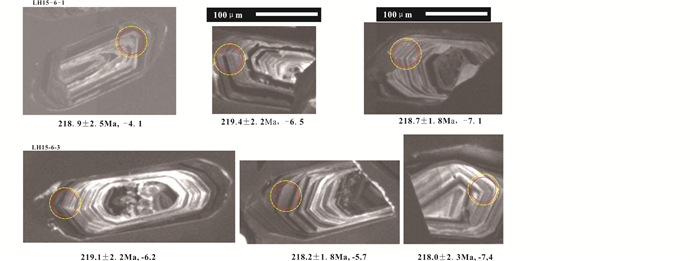
|
图 6 梁河正长花岗岩锆石阴极发光图像(红色圈代表年龄测试点位; 黄色圈代表Hf同位素测试点位) Fig. 6 Cathodoluminescence (CL) images of zircon grains from the syenogranite in Lianghe |

|
图 7 梁河正长花岗岩锆石U-Pb年龄谐和图 Fig. 7 Zircon U-Pb age concordia plots of syenogranite in Lianghe |
样品(LH15-6-3)中的锆石颗粒多为自形或半自形,长柱状或短柱状晶体,长约60~200μm,长宽比为1.3: 1~5: 1,锆石阴极发光图像可见清晰的生长环带(图 6),大部分锆石的Th/U比值大于0.1,认为也属于典型的岩浆成因锆石。共分析8个测点,均分布在U-Pb年龄谐和曲线上及其附近。锆石年龄测试点都选在锆石环带边部,8个测试点206Pb/238U年龄值范围在216.6~219.4Ma,谐和年龄值为218.3±0.75Ma(MSWD=4.6)(图 7b),变化范围较小,显示出良好的谐和性。
3.3 锆石Hf同位素特征本文对2件样品进行了Hf同位素分析,结果见表 3。样品LH15-6-1共分析了9个点,176Lu/177Hf的比值范围是0.001035~0.002378,176Yb/177Hf比值范围是0.035440~0.082290。样品LH15-6-3共分析了8个点,176Lu/177Hf的比值范围是0.000594~0.002252,176Yb/177Hf比值范围是0.022341~0.080557。大部分176Lu/177Hf比值小于0.002,表明锆石在形成以后,由176Lu衰变而形成放射性成因Hf的积累较少,因此可用初始176Hf/177Hf的值代表锆石形成时的176Hf/177Hf的值(吴福元等, 2007)。样品LH15-6-1和LH15-6-3中的分析点年龄集中在(~218Ma),176Hf/177Hf变化范围为0.282339~0.282520和0.282350~0.282528,εHf(t)为-10.74~-4.14,对应的Hf同位素地壳模式年龄tDMC为1516~1935Ma(表 3、图 8)。样品fLu/Hf的平均值为-0.95,明显小于镁铁质地壳的fLu/Hf(-0.34)(Amelin et al., 2000)和硅铝质地壳的fLu/Hf(-0.72)(Vervoort et al., 1996)。所以二阶段模式年龄更能反映其源区物质从亏损地幔被抽取的时间(或其源区物质在地壳的平均存留年龄)。
|
|
表 3 梁河正长花岗岩体锆石Hf同位素数据 Table 3 Zircon Hf isotopic data of the syenogranite in Lianghe |
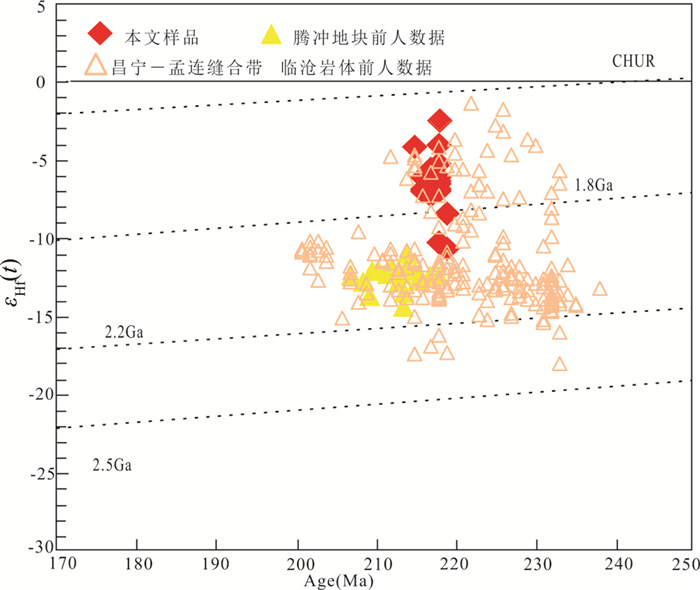
|
图 8 梁河正长花岗岩εHf(t)值对U-Pb年龄图 前人数据据丛峰等, 2010; 聂飞等, 2012; Dong et al., 2013; Peng et al., 2013; 黄志英等, 2013; Wang et al., 2015; Deng et al., 2017b Fig. 8 εHf(t) vs. U-Pb ages plot of syenogranite in Lianghe |
昌宁-孟连结合带做为古特提斯主洋盆于晚二叠世-早三叠世闭合(Metcalfe 2009; 李兴振等, 2002),造成保山地块与思茅地块碰撞拼合。到晚三叠世,随着碰撞造山的进行,形成了一系列碰撞后岩浆活动。
前人研究表明,腾冲北部印支期二云母钾长花岗岩年龄~235.2Ma(赵成峰, 1999);腾冲梁河县城东二云母花岗岩侵位年龄256±5.6Ma、234.1±3.1Ma(李再会等, 2010);那邦东南侧的糜棱岩化花岗闪长玢岩年龄为219.9±1.3Ma(李化启等, 2011);芒市西南侧的片麻状含石英黑云闪长岩定年结果为206±4.5Ma(李化启等, 2011);梁河县南部龙塘二长花岗岩体形成于232.1±5.6Ma(邹光富等, 2011);腾冲梁河花岗岩侵位时间213.1±1.7Ma(丛峰等, 2010);腾冲地块东部那邦闪长岩体定年结果245±2.9Ma(黄志英等, 2013)。
本文研究对梁河附近的正长花岗岩进行锆石LA-ICP-MS U-Pb定年,测得其侵位年龄为218.3±0.75Ma(MSWD=4.6)和218.6±0.64Ma(MSWD=1.7)。结果与前人研究年龄大体相同。综合前人结果,发现腾冲地块在早三叠世、中三叠世到晚三叠世,都有岩浆活动发生,表明腾冲岩体在古特提斯闭合碰撞过程中及后碰撞阶段发生了多次的岩浆活动。
4.2 岩石成因类型M型、I型、S型和A型是目前最常用的花岗岩成因分类方案(Chappell and White, 1974, 1992; Bonin, 2007),本次11件样品K2O值3.49%~5.54%,均大于1%,因此不属于M型花岗岩(M型花岗岩K2O<1%, Bonin, 2007)。I型花岗岩为准铝质的(Chappell and White, 1974, 1992),本次样品中镜下能见到少量白云母,铝饱和指数(A/CNK)为1.00~1.12,显示铝饱和标志。I型和M型花岗岩一般K2O/Na2O<1,本次样品K2O/Na2O比值(1.05~2.14)都大于1,因此不可能是I型或M型花岗岩。在花岗岩成因类型判别图(图 9a, b)中,11件样品都落入I型和S型花岗岩区域,其中10件样品落入未结晶分异的花岗岩范围内(图 9a), 说明岩体的结晶分异程度较低。另外,本次样品中的锆石含有继承锆石核(图 6),全岩锆饱和温度集中在524~761℃(1个异常温度除外),平均锆饱和温度为~655℃,A型花岗岩锆饱和温度>830℃(King et al., 2001),因此这些都表明本次研究的正长花岗岩不属于A型花岗岩。
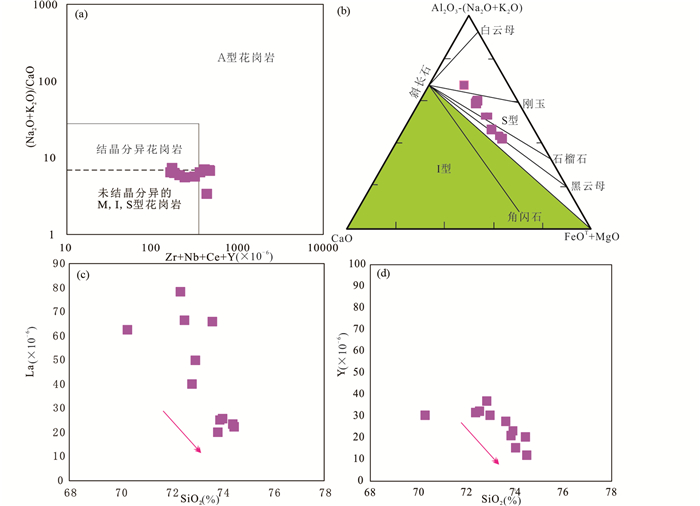
|
图 9 梁河正长花岗岩成因类型判别图 (a)(Na2O+K2O)/CaO-(Zr+Nb+Ce+Y) (Whalen et al., 1987); (b) A-C-F (A=Al2O3-(Na2O+K2O); C=CaO; F=FeOT+MgO; Chappell and White, 1992); (c) SiO2-La (Chappell, 1999); (d) SiO2-Y (Chappell, 1999) Fig. 9 Discrimination diagrams for the genetic types of the syenogranite in Lianghe |
在ACF判别图中(图 9b),11件样品全部落在S型岩体区域,在SiO2-La和SiO2-Y关系图中(图 9c, d),La、Y与SiO2显示出负相关,都符合S型花岗岩的特点。I型花岗岩中,La、Y与SiO2正相关(Chappell, 1999),这些都进一步证明本次研究的正长花岗岩为S型花岗岩。
4.3 源区性质源岩识别是研究花岗岩的重要部分,CaO/Na2O可作为源区的重要判别标志(Sylvester, 1998),富粘土源区的过铝-强过铝质花岗岩的CaO/Na2O<0.3,比值较低;源区富斜长石、贫粘土碎屑岩源区的过铝-强过铝质花岗岩CaO/Na2O>0.3,比值较大(Patiño Douce and Johnston, 1991)。Hf同位素的研究表明,εHf(t)<0的岩石为古老地壳部分熔融形成的(Griffin et al., 2004; Vervoort et al., 2000)。
本次11个样品的CaO/Na2O(0.35~0.61)大于0.3,在Al2O3/TiO2-CaO/Na2O图解中(图 10a),11个样品均落入砂屑岩源区范围内,样品的锆石颗粒的εHf(t)值在-10.74~-4.14之间,对应二阶段模式年龄tDMC为1.5~1.9Ga(表 3),在εHf(t)值与U-Pb年龄图解(图 8)中样品都落在下地壳区域,结合前人发表的晚二叠世到早三叠世腾冲花岗岩锆石εHf(t)数据及临沧~220Ma花岗岩εHf(t)数据(图 8),表明其岩浆来源于古老地壳沉积物的重熔,源区没有幔源物质的加入。
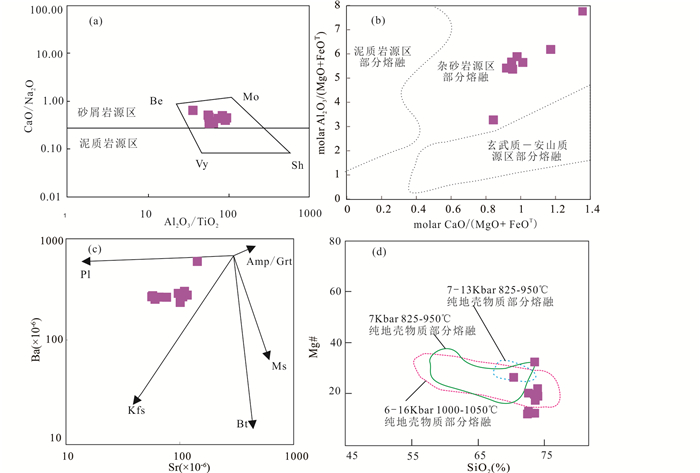
|
图 10 梁河正长花岗岩岩浆源区判别图 (a) CaO/Na2O-Al2O3/TiO2 (Sylvester, 1998); (b) molar Al2O3/(MgO+FeOT)-CaO/(MgO+FeOT) (Altherr et al., 2000); (c) Sr-Ba (Hanson, 1978); (d) SiO2-Mg# (Jiang et al., 2013) Fig. 10 Discrimination diagrams for the potential magma of the syenogranite in Lianghe |
另外,本次岩石样品CaO/(MgO+FeOT)的值在0.84~1.71之间,Al2O3/(MgO+FeOT)的值在3.27~10.2之间,在Al2O3/(MgO+FeOT)-CaO/(MgO+FeOT)图中(图 10b)样品全部投在变质杂砂岩源区(Altherr et al., 2000);样品的Mg#值12.4~37.7之间,在Mg#-SiO2图解中(图 10d)几乎全部落入纯地壳物质部分熔融范围内(Jiang et al., 2013),这些都证明成岩岩浆来源于地壳物质的重熔,没有基性岩浆的混合。
大部分样品的Nb/La值较低(0.32~0.97)小于1,表明岩体源区有陆壳物质参与;Nb/Ta比值为7.43~40.73,平均值14.5,接近壳源岩浆的特征(12~13, Barth et al., 2000);Zr/Hf比值范围为26.6~32.7,平均29,按近壳源岩石(33左右, Taylor and McLennan, 1985; Green, 1995)。δEu平均值为0.37<1(表 1),为负异常,中等亏损,属壳型花岗岩(平均值0.46,Henderson, 1984)。同时,岩石具有相对低的锆饱和温度(表 1),平均~655℃,说明其没有幔源岩浆的加入。
在主量变异图解中(图 4),SiO2与其他氧化物Al2O3、CaO、Na2O、TiO2、FeOT、MgO呈线性负相关趋势,表明在分离结晶过程中成分的连续变化。在微量元素中亏损Ba、Nb、Ta、Sr、Ti,这些特征与壳源熔融相似(Chappell and White, 1992; Bea et al., 2011)。本次研究Sr值为58.30×10-6~147.1×10-6,Ba值集中在228.7×10-6~597.9×10-6。在Sr-Ba图解中(图 10c),也显示了斜长石发生了分离结晶。因此,梁河正长花岗岩起源于下地壳的重融,并且随后发生一系列的分离结晶作用。
研究表明Al2O3/TiO2比值可以作为源区岩石部分熔融温度的指示剂(Sylvester, 1998),当岩石的Al2O3/TiO2比值>100时,源区部分熔融温度<875℃;当岩石的Al2O3/TiO2比值<100时,源区部分熔融温度>875℃。本次研究的11件样品的Al2O3/TiO2比值为33~91,小于100,所以源区部分熔融温度超过875℃。
综上所述,腾冲地块梁河晚三叠世正长花岗岩可能是在地下高温的烘烤下,以砂屑质沉积岩为主发生部分熔融的产物,并且没有地幔物质的参与。
4.4 构造环境三叠纪腾冲地块西部花岗岩年龄为(245~206Ma, Li et al., 2011; Huang et al., 2013),东部年龄为(234~213Ma, 邹光富等, 2011; 丛峰等, 2010; 李再会等, 2010; 李化启等, 2011)。但腾冲三叠纪花岗岩目前其形成构造背景存在争议,例如前人认为腾冲花岗岩形成于后碰撞伸展环境(丛峰等, 2010),也有学者认为腾冲花岗岩可能形成于碰撞造山环境(李再会等, 2010)。本文结合保山、临沧及区域上三叠纪花岗岩研究成果,对腾冲花岗岩的构造环境进行分析。
临沧花岗岩基年龄的形成时代在261~203Ma,可分为不同期次花岗岩。晚二叠世形成年龄261Ma和253Ma(Deng et al., 2017b);中三叠世231~233Ma和228~223Ma(Dong et al., 2013; Peng et al., 2013; 王舫等, 2014; Wang et al., 2015);晚三叠世219~203Ma(Dong et al., 2013; Wang et al., 2015; Deng et al., 2017b)。古特提斯洋在~252Ma以前处于俯冲阶段,在250~237Ma同碰撞期,235~203Ma是后碰撞阶段(Deng et al., 2017b),后碰撞伸展减压作用下形成了临沧北部、南部和景洪西侧的后碰撞二长花岗岩、花岗岩(~203Ma、~219Ma和~216Ma)。
保山地块在中晚三叠世(~230Ma)发育碰撞后“S”型花岗岩;拉萨地体中、南部岩体侵位年龄(228~205Ma);云县-景谷岩浆带发育后碰撞花岗岩(230~210Ma);开心岭岩浆带~230Ma花岗岩属于后碰撞类型;雅轩桥岩浆带在早中三叠世(260~230Ma)发育后碰撞侵入岩;江达-维西岩浆带(250~230Ma)侵入岩属于后碰撞型;义敦岛弧带发育俯冲型花岗岩(230~200Ma)(禹丽,2016)。
由于古特提斯洋的俯冲和消减,三叠纪腾冲地块形成一系列岩浆构造事件。期间发现的S型花岗岩被认为是同碰撞花岗岩(Cao et al., 2018)。腾冲地块内缺失上二叠统-中三叠统地层暗示地块在该时期构造活动较多(Yin and Harrison, 2000)。晚三叠世~205Ma盈江变辉长岩地球化学和同位素证据显示其与板内环境有亲缘性(Zhu et al., 2018)。在东特提斯构造域由于古特提洋闭合在晚三叠世~220Ma形成后碰撞花岗岩(Peng et al., 2013)。从中三叠世到晚三叠世,腾冲地块由于古特提斯洋闭合形成一系列同碰撞和后碰撞的花岗岩。
古特提斯昌宁-孟连洋在晚三叠世最终关闭,其后碰撞阶段在滇缅泰马微大陆内部引发了广泛地壳伸展和大规模推覆走滑运动,在保山地块和腾冲地块产生潞西海槽。在龙陵-瑞丽断裂发生大规模韧性推覆作用(丛峰等, 2010)。同时,保山地块潞西海槽的东延部分在晚三叠世发育大量大陆玄武岩(云南省地质矿产局, 1990)。这些都印证了腾冲地块内部在晚三叠世可能处于后碰撞地壳伸展背景。
本次研究样品U-Pb年龄支持梁河正长花岗岩形成于晚三叠世,在(Y+Nb)-Rb图解和(Y+Ta)-Rb图解中,样品点投到板内-后碰撞区域(图 11)。表明腾冲梁河正长花岗岩是在板内后碰撞伸展背景下,由于地壳伸展诱发减压熔融形成的岩浆活动中发育形成的。

|
图 11 梁河正长花岗岩构造判别图(据Pearce et al., 1984; Pearce, 1996) Fig. 11 Geochemincal discrimination diagrams of Rb vs. Y+Nb (a) and Y+Ta (b) of the syenogranite in Lianghe (after Pearce et al., 1984; Pearce, 1996) |
(1) 腾冲地块梁河正长花岗岩锆石LA-ICP-MS U-Pb定年结果表明,岩体侵位于晚三叠世(~218Ma)。属于高钾钙碱性,过铝质“S”型花岗岩,由下地壳砂屑岩在较高温度下部分熔融形成。
(2) 腾冲地块梁河正长花岗岩锆石Hf同位素测试结果表明,εHf(t)均为负值,范围集中在-10.74~-4.14,对应地壳模式年龄集中在1.5~1.9Ga,推断为古老地壳部分熔融的产物。
(3) 结合区域研究结果表明,晚三叠世梁河正长花岗岩可能形成于后碰撞伸展背景下的古老地壳熔融。
致谢 论文成文过程中得到中国地质大学(北京)张方方老师、赵睿博士、崔晓琳博士、郑震博士、赵枫博士、吴华英博士、张琦玮硕士、张铎硕士的指导和帮助。实验室测试分析得到中国地质大学(武汉)地质过程与矿产资源国家重点实验室和长安大学国土资源部成矿作用及其动力学开放实验室工作人员的帮助。在此一并表示衷心的感谢!
Altherr R, Holl A, Hegner E, Langer C and Kreuzer H. 2000. High-potassium, calc-alkaline Ⅰ-type plutonism in the European Variscides:Northern Vosges (France) and northern Schwarzwald (Germany). Lithos, 50(1-3): 51-73. DOI:10.1016/S0024-4937(99)00052-3 |
Amelin Y, Lee DC and Halliday AN. 2000. Early-middle archaean crustal evolution deduced from Lu-Hf and U-Pb isotopic studies of single zircon grains. Geochimica et Cosmochimica Acta, 64(24): 4205-4225. DOI:10.1016/S0016-7037(00)00493-2 |
Bai XZ, Jia XC, Yang XJ, Xiong CL, Liang B, Huang BX and Luo G. 2012. LA-ICP-MS zircon U-Pb dating and geochemical characteristics of Early Cretaceous volcanic rocks in Longling-Ruili fault belt, western Yunnan Province. Geological Bulletin of China, 31(2-3): 297-305. |
Barth MG, McDonough WF and Rudnick RL. 2000. Tracking the budget of Nb and Ta in the continental crust. Chemical Geology, 165(3-4): 197-213. DOI:10.1016/S0009-2541(99)00173-4 |
Bea F, Mazhari A, Montero P, Amini S and Ghalamghash J. 2011. Zircon dating, Sr and Nd isotopes, and element geochemistry of the Khalifan pluton, NW Iran:Evidence for Variscan magmatism in a supposedly Cimmerian superterrane. Journal of Asian Earth Sciences, 40(1): 172-179. DOI:10.1016/j.jseaes.2010.08.005 |
Blichert-Toft J and Albarède F. 1997. The Lu-Hf isotope geochemistry of chondrites and the evolution of the mantle-crust system. Earth and Planetary Science Letters, 148(1-2): 243-258. DOI:10.1016/S0012-821X(97)00040-X |
Bonin B. 2007. A-type granites and related rocks:Evolution of a concept, problems and prospects. Lithos, 97(1-2): 1-29. DOI:10.1016/j.lithos.2006.12.007 |
Bureau of Geology and Resources of Yunnan Province. 1990. Regional Geology of Yunnan Province. Beijing: Geological Publishing House: 1-658.
|
Cao HW, Zhang ST, Lin JZ, Zheng L, Wu JD and Li D. 2014. Geology, geochemistry and geochronology of the Jiaojiguanliangzi Fe-polymetallic deposit, Tengchong County, western Yunnan (China):Regional tectonic implications. Journal of Asian Earth Sciences, 81: 142-152. DOI:10.1016/j.jseaes.2013.11.002 |
Cao HW, Zou H, Zhang YH, Zhang ST, Zheng L, Zhang LK, Tang L and Pei QM. 2016. Late Cretaceous magmatism and related metallogeny in the Tengchong area:Evidence from geochronological, isotopic and geochemical data from the Xiaolonghe Sn deposit, western Yunnan, China. Ore Geology Reviews, 78: 196-212. DOI:10.1016/j.oregeorev.2016.04.002 |
Cao HW, Zhang YH, Tang L, Hollis SP, Zhang ST, Pei QM, Yang C and Zhu XS. 2018. Geochemistry, zircon U-Pb geochronology and Hf isotopes of Jurassic-Cretaceous granites in the Tengchong terrane, SW China:Implications for the Mesozoic tectono-magmatic evolution of the Eastern Tethyan Tectonic Domain. International Geology Review. DOI:10.1080/00206814.2017.1422445 |
Chappell BW and White AJR. 1974. Two contrasting granite types. Pacific Geology, 8: 173-174. |
Chappell BW and White AJR. 1992. I-and S-type granites in the Lachlan Fold Belt. Earth and Environmental Science Transactions of the Royal Society of Edinburgh, 83(1-2): 1-26. DOI:10.1017/S0263593300007720 |
Chappell BW. 1999. Aluminium saturation in I-and S-type granites and the characterization of fractionated haplogranites. Lithos, 46(3): 535-551. DOI:10.1016/S0024-4937(98)00086-3 |
Chen FC, Deng J, Shu QH, Li GJ, Cui XL, Zhao F and Wang QF. 2017. Geology, fluid inclusion and stable isotopes (O, S) of the Hetaoping distal skarn Zn-Pb deposit, northern Baoshan Block, SW China. Ore Geology Reviews, 90: 913-927. DOI:10.1016/j.oregeorev.2016.10.013 |
Chen JC, Lin WX and Chen LZ. 1991. Series and unit research on tin-bearing granites of Tengchong-Lianghe area. Yunnan Geology, 10(3): 241-289. |
Chen XC, Hu RZ, Bi XW, Li HM, Lan JB, Zhao CH and Zhu JJ. 2014. Cassiterite LA-MC-ICP-MS U/Pb and muscovite 40Ar/39Ar dating of tin deposits in the Tengchong-Lianghe tin district, NW Yunnan, China. Mineralium Deposita, 49(7): 843-860. DOI:10.1007/s00126-014-0513-8 |
Chen XC, Hu RZ, Bi XW, Zhong H, Lan JB, Zhao CH and Zhu JJ. 2015. Petrogenesis of metaluminous A-type granitoids in the Tengchong-Lianghe tin belt of southwestern China:Evidences from zircon U-Pb ages and Hf-O isotopes, and whole-rock Sr-Nd isotopes. Lithos, 212. |
Cong F, Lin SL, Tang HF, Xie T, Li ZH, Zou GF, Peng ZM and Liang T. 2010. Trace elements and Hf isotope compositions and U-Pb age of igneous zircons from the Triassic granite in Lianghe, western Yunnan. Acta Geologica Sinica, 84(8): 1155-1164. |
Cong F, Lin SL, Zou GF, Xie T, Li ZH, Tang FW and Peng ZM. 2011. Geochronology and petrogenesis for the protolith of biotite plagioclase gneiss at Lianghe, western Yunnan. Acta Geologica Sinica, 85(4): 870-880. DOI:10.1111/acgs.2011.85.issue-4 |
Deng J, Yang LQ and Wang CM. 2011. Research advances of superimposed orogenesis and metallogenesis in the Sanjiang Tethys. Acta Petrologica Sinica, 27(9): 2501-2509. |
Deng J, Wang CM and Li GJ. 2012. Style and process of the superimposed mineralization in the Sanjiang Tethys. Acta Petrologica Sinica, 28(5): 1349-1361. |
Deng J, Wang QF, Li GJ, Li CS and Wang CM. 2014a. Tethys tectonic evolution and its bearing on the distribution of important mineral deposits in the Sanjiang region, SW China. Gondwana Research, 26(2): 419-437. DOI:10.1016/j.gr.2013.08.002 |
Deng J, Wang QF, Li GJ and Santosh M. 2014b. Cenozoic tectono-magmatic and metallogenic processes in the Sanjiang region, southwestern China. Earth-Science Reviews, 138: 268-299. DOI:10.1016/j.earscirev.2014.05.015 |
Deng J. 2016. Superimposed Orogenesis and Metallogenesis in the Sanjiang Tethys. Beijing: Science Press: 1-640.
|
Deng J, Wang QF and Li GJ. 2016. Superimposed orogeny and composite metallogenic system:Case study from the Sanjiang Tethyan belt, SW China. Acta Petrologica Sinica, 32(8): 2225-2247. |
Deng J, Wang QF and Li GJ. 2017a. Tectonic evolution, superimposed orogeny, and composite metallogenic system in China. Gondwana Research 50: 216-266. |
Deng J, Wang CM, Zi JW, Xia R and Li Q. 2017b. Constraining subduction-collision processes of the Paleo-Tethys along the Changning-Menglian Suture:New zircon U-Pb ages and Sr-Nd-Pb-Hf-O isotopes of the Lincang Batholith. Gondwana Research. DOI:10.1016/j.gr.2017.10.008 |
Dong FL, Hou ZQ, Gao YF, Zeng PS and Jiang CX. 2006. Cenozoic granitoid in Tengchong, western Yunnan:Genesis type and implication for tectonics. Acta Petrologica Sinica, 22(4): 927-937. |
Dong GC, Mo XX, Zhao ZD, Zhu DC, Goodman RC, Kong HL and Wang S. 2013. Zircon U-Pb dating and the petrological and geochemical constraints on Lincang granite in western Yunnan, China:Implications for the closure of the Paleo-Tethys Ocean. Journal of Asian Earth Sciences, 62: 282-294. DOI:10.1016/j.jseaes.2012.10.003 |
Dong ML. 2016. Study of magmatism in Tengchong-Baoshan Block, western Yunnan and its tectonic implications. Ph. D. Dissertation. Beijing: China University of Geosciences (Beijing).
|
Eroğlu S, Siebel W, Danišík M, Pfänder JA and Chen FK. 2013. Multi-system geochronological and isotopic constraints on age and evolution of the Gaoligongshan metamorphic belt and shear zone system in western Yunnan, China. Journal of Asian Earth Sciences, 73: 218-239. DOI:10.1016/j.jseaes.2013.03.031 |
Green TH. 1995. Significance of Nb/Ta as an indicator of geochemical processes in the crust-mantle system. Chemical Geology, 120(3-4): 347-359. DOI:10.1016/0009-2541(94)00145-X |
Griffin WL, Belousova EA, Shee SR, Pearson NJ and O'Reilly SY. 2004. Archean crustal evolution in the northern Yilgarn Craton:U-Pb and Hf-isotope evidence from detrital zircons. Precambrian Research, 131(3-4): 231-282. DOI:10.1016/j.precamres.2003.12.011 |
Hanson GN. 1978. The application of trace elements to the petrogenesis of igneous rocks of granitic composition. Earth and Planetary Science Letters, 38(1): 26-43. DOI:10.1016/0012-821X(78)90124-3 |
Henderson P. 1984. Rare Earth Element Geochemistry. Elsevier Science Publishers: 115-152. |
Hoskin PWO and Schaltegger U. 2003. The composition of zircon and igneous and metamorphic petrogenesis. Reviews in Mineralogy and Geochemistry, 53(1): 27-62. DOI:10.2113/0530027 |
Hou ZQ, Zaw K, Pan GT, Mo XX, Xu Q, Hu YZ and Li XZ. 2007. Sanjiang tethyan metallogenesis in S. W. China:Tectonic setting, metallogenic epochs and deposit types. Ore Geology Reviews, 31(1-4): 48-87. |
Hu ZC, Liu YS, Gao S, Liu WG, Zhang W, Tong XR, Lin L, Zong KQ, Li M, Chen HH, Zhou L and Yang L. 2012. Improved in situ Hf isotope ratio analysis of zircon using newly designed X skimmer cone and jet sample cone in combination with the addition of nitrogen by laser ablation multiple collector ICP-MS. Journal of Analytical Atomic Spectrometry, 27(9): 1391-1399. DOI:10.1039/c2ja30078h |
Huang ZY, Qi XX, Tang GZ, Liu JK, Zhu LH, Hu ZC, Zhao YH and Zhang C. 2013. The identification of Early Indosinian tectonic movement in Tengchong block, western Yunnan:Evidence of zircon U-Pb dating and Lu-Hf isotope for Nabang diorite. Geology in China, 40(3): 730-741. |
Jiang YH, Jia RY, Liu Z, Liao SY, Zhao P and Zhou Q. 2013. Origin of Middle Triassic high-K calc-alkaline granitoids and their potassic microgranular enclaves from the western Kunlun orogen, Northwest China:A record of the closure of Paleo-Tethys. Lithos, 156-159: 13-30. DOI:10.1016/j.lithos.2012.10.004 |
King PL, Chappell BW, Allen CM and White AJR. 2001. Are A-type granites the high-temperature felsic granites? Evidence from fractionated granites of the Wangrah Suite. Australian Journal of Earth Sciences, 48(4): 501-514. DOI:10.1046/j.1440-0952.2001.00881.x |
Li HQ, Xu ZQ, Cai ZH, Tang ZM and Yang M. 2011. Indosinian epoch magmatic event and geological significance in the Tengchong block, western Yunnan Province. Acta Petrologica Sinica, 27(7): 2165-2172. |
Li XZ, Jiang XS, Sun ZM, Shen GF and Du DX. 2002. The Collisional Orogenic Processes of the Nujiang-Lancanjiang-Jinshajiang Area, Southwestern China. Beijing: Geological Publishing House: 1705-1728.
|
Li ZH, Lin SL, Cong F, Zou GF and Xie T. 2010. Indosinian orogenesis of the Tengchong-Lianghe block, western Yunnan:Evidence from zircon U-Pb dating and petrogenesis of granitoids. Acta Petrologica et Mineralogica, 29(3): 298-312. |
Li ZH, Lin SL, Cong F, Xie T and Zou GF. 2012. U-Pb ages of zircon from metamorphic rocks of the Gaoligongshan Group in western Yunnan and its tectonic significance. Acta Petrologica Sinica, 28(5): 1529-1541. |
Liang YH, Chung SL, Liu DY, Xu YG, Wu FY, Yang JH, Wang YB and Lo CH. 2008. Detrital zircon evidence from Burma for reorganization of the eastern Himalayan river system. American Journal of Science, 308(4): 618-638. DOI:10.2475/04.2008.08 |
Liu YS, Hu ZC, Gao S, Günther D, Xu J, Gao CG and Chen HH. 2008. In situ analysis of major and trace elements of anhydrous minerals by LA-ICP-MS without applying an internal standard. Chemical Geology, 257(1-2): 34-43. DOI:10.1016/j.chemgeo.2008.08.004 |
Liu YS, Gao S, Hu ZC, Gao CG, Zong KQ and Wang DB. 2010a. Continental and oceanic crust recycling-induced melt-peridotite interactions in the Trans-North China Orogen:U-Pb dating, Hf isotopes and trace elements in zircons from mantle xenoliths. Journal of Petrology, 51(1-2): 537-571. DOI:10.1093/petrology/egp082 |
Liu YS, Hu ZC, Zong KQ, Gao CG, Gao S, Xu J and Chen HH. 2010b. Reappraisement and refinement of zircon U-Pb isotope and trace element analyses by LA-ICP-MS. Chinese Science Bulletin, 55(15): 1535-1546. DOI:10.1007/s11434-010-3052-4 |
Ludwig KR. 2003. Isoplot 3.00:A Geochronological Toolkit for Microsoft Excel. California: Berkeley Geochronology Center.
|
Luo G, Jia XC, Yang XJ, Xiong CL, Bai XZ, Huang BX and Tan XL. 2012. LA-ICP-MS zircon U-Pb dating of southern Menglian granite in Tengchong area of western Yunnan Province and its tectonic implications. Geological Bulletin of China, 31(2-3): 287-296. |
Lü BX, Wang Z, Zhang ND, Duan JZ, Gao ZY, Shen GF, Pan CY and Yao P. 1993. Granitoids in the Sanjiang Region (Nujiang-Lancangjiang-Jinshajiang Region) and Their Metallogenic Specialization. Beijing: Geological Publishing House.
|
Maniar PD and Piccoli PM. 1989. Tectonic discrimination of granitoids. GSA Bulletin, 101(5): 635-643. DOI:10.1130/0016-7606(1989)101<0635:TDOG>2.3.CO;2 |
McDonough WF and Sun SS. 1995. The composition of the Earth. Chemical Geology, 120(3-4): 223-253. DOI:10.1016/0009-2541(94)00140-4 |
Metcalfe I. 2002. Permian tectonic framework and palaeogeography of SE Asia. Journal of Asian Earth Sciences, 20(6): 551-566. DOI:10.1016/S1367-9120(02)00022-6 |
Metcalfe I. 2006. Palaeozoic and Mesozoic tectonic evolution and palaeogeography of East Asian crustal fragments:the Korean Peninsula in context. Gondwana Research, 9: 24-46. DOI:10.1016/j.gr.2005.04.002 |
Metcalfe I. 2009. Late Palaeozoic and Mesozoic tectonic and palaeogeographic evolutionof SE Asia. The Geological Society London Special Publications, 315: 7-23. DOI:10.1144/SP315.2 |
Metcalfe I. 2011. Tectonic framework and Phanerozoic evolution of Sundaland. Gondwana Research, 19(1): 3-21. DOI:10.1016/j.gr.2010.02.016 |
Metcalfe I. 2013. Gondwana dispersion and Asian accretion:Tectonic and palaeogeographic evolution of Eastern Tethys. Journal of Asian Earth Sciences, 66: 1-33. DOI:10.1016/j.jseaes.2012.12.020 |
Metcalfe I and Aung KP. 2014. Late Tournaisian conodonts from the Taungnyo Group near Loi Kaw, myanmar (Burma):Implications for Shan plateau stratigraphy and evolution of the Gondwana-derived Sibumasu terrane. Gondwana Research, 26(3-4): 1159-1172. DOI:10.1016/j.gr.2013.09.004 |
Middlemost EAK. 1985. Magmas and Magmatic Rocks. London Longman: 1-266. |
Mo XX, Lu FX, Shen SY, Zhu QW, Hou ZQ, Yang KH, Deng FJ, Liu XP and He CX. 1993. Sanjiang Tethyan Volcanism and Related Mineralization. Beijing: Geological Publishing House: 1-267.
|
Nie F, Dong GC, Mo XX, Zhu DC, Dong ML and Wang X. 2012. Geochemistry, zircon U-Pb chronology of the Triassic granites in the Changning-Menglian suture zone and their implications. Acta Petrologica Sinica, 28(5): 1465-1476. |
Pan GT, Li XZ, Wang LQ, Ding J and Chen ZL. 2002. Preliminary division of tectonic units of the Qinghai-Tibet Plateau and its adjacent regions. Geological Bulletin of China, 21(11): 701-707. |
Patiño Douce AE and Johnston AD. 1991. Phase equilibria and melt productivity in the pelitic system:Implications for the origin of peraluminous granitoids and aluminous granulites. Contributions to Mineralogy and Petrology, 107(2): 202-218. DOI:10.1007/BF00310707 |
Pearce JA, Harris NBW and Tindle AG. 1984. Trace element discrimination diagrams for the tectonic interpretation of granitic rocks. Journal of Petrology, 25: 956-983. DOI:10.1093/petrology/25.4.956 |
Pearce JA. 1996. Sources and settings of granitic rocks. Episodes, 19: 120-125. |
Peccerillo R and Taylor SR. 1976. Geochemistry of Eocene cale-alkaline volcanic rocks from the Kastamonu area, northern Turkey. Contributions to Mineralogy and Petrology, 58(1): 63-81. DOI:10.1007/BF00384745 |
Peng TP, Wilde SA, Wang YJ, Fan WM and Peng BX. 2013. Mid-Triassic felsic igneous rocks from the southern Lancangjiang Zone, SW China:Petrogenesis and implications for the evolution of Paleo-Tethys. Lithos, 168-169: 15-32. DOI:10.1016/j.lithos.2013.01.015 |
Ping XQ, Zheng JP, Zhao JH, Tang HY and Griffin WL. 2013. Heterogeneous sources of the Triassic granitoid plutons in the southern Qinling orogen:An E-W tectonic division in central China. Tectonics, 32(3): 396-416. DOI:10.1002/tect.v32.3 |
Qi XX, Zhu LH, Grimmer JC and Hu ZC. 2015. Tracing the Transhimalayan magmatic belt and the Lhasa block southward using zircon U-Pb, Lu-Hf isotopic and geochemical data:Cretaceous-Cenozoic granitoids in the Tengchong block, Yunnan, China. Journal of Asian Earth Sciences, 110: 170-188. DOI:10.1016/j.jseaes.2014.07.019 |
Searle MP, Noble SR, Cottle JM, Waters DJ, Mitchell AHG, Hlaing T and Horstwood MSA. 2007. Tectonic evolution of the Mogok metamorphic belt, Burma (Myanmar) constrained by U-Th-Pb dating of metamorphic and magmatic rocks. Tectonics, 26(3): TC3014. |
Shi YK, Jin XC, Huang H and Yang XN. 2008. Permian fusulinids from the Tengchong block, western Yunnan, China. The Paleontological Society, 82(1): 118-127. |
Söderlund U, Patchett PJ, Vervoort JD and Isachsen CE. 2004. The 176Lu decay constant determined by Lu-Hf and U-Pb isotope systematics of Precambrian mafic intrusions. Earth and Planetary Science Letters, 219(3-4): 311-324. DOI:10.1016/S0012-821X(04)00012-3 |
Streckeisen AL. 1976. Classification of the common igneous rocks by means of their chemical composition:A provisional attempt. Neues Jahrbuch für Mineralogie, Monatshefte: 1-15. |
Sun SS and McDonough WF. 1989. Chemical and isotopic systematics of oceanic basalts: Implications for mantle composition and processes. In: Saunders AD and Norry MJ (eds. ). Magmatism in the Ocean Basins. Geological Society, London, Special Publication, 42(1): 313-345
|
Sylvester PJ. 1998. Post-collisional strongly peraluminous granites. Lithos, 45(1-4): 29-44. DOI:10.1016/S0024-4937(98)00024-3 |
Taylor SR and McLennan SM. 1985. The Continental Crust:Its Composition and Evolution:An Examination of the Geochemical Record Preserved in Sedimentary Rocks. Oxford: Blackwell Scientific Publications: 91-92.
|
Vervoort JD, Patchett PJ, Gehrels GE and Nutman AP. 1996. Constraints on early Earth differentiation from hafnium and neodymium isotopes. Nature, 379(6566): 624-627. DOI:10.1038/379624a0 |
Vervoort JD, Patchett PJ, Albarède F, Blichert-Toft J, Rudnick R and Downes H. 2000. Hf-Nd isotopic evolution of the lower crust. Earth and Planetary Science Letters, 181(1-2): 115-129. DOI:10.1016/S0012-821X(00)00170-9 |
Wang CM, Deng J, Carranza EJM and Santosh M. 2014a. Tin metallogenesis associated with granitoids in the southwestern Sanjiang Tethyan Domain:Nature, deposit types, and tectonic setting. Gondwana Research, 26(2): 576-593. DOI:10.1016/j.gr.2013.05.005 |
Wang CM, Deng J, Santosh M, Lu YJ, McCuaig TC, Carranza EJM and Wang QF. 2015. Age and origin of the Bulangshan and Mengsong granitoids and their significance for post-collisional tectonics in the Changning-Menglian Paleo-Tethys Orogen. Journal of Asian Earth Sciences, 113: 656-676. DOI:10.1016/j.jseaes.2015.05.001 |
Wang CM, Bagas L, Lu YJ, Santosh M, Du B and McCuaig TC. 2016. Terrane boundary and spatio-temporal distribution of ore deposits in the Sanjiang Tethyan Orogen:Insights from zircon Hf-isotopic mapping. Earth-Science Reviews, 156: 39-65. DOI:10.1016/j.earscirev.2016.02.008 |
Wang CM, Deng J, Bagas L and Wang Q. 2017. Zircon Hf-isotopic mapping for understanding crustal architecture and metallogenesis in the Eastern Qinling Orogen. Gondwana Research, 50: 293-310. DOI:10.1016/j.gr.2017.04.008 |
Wang CM, Bagas L, Chen JY, Yang LF, Zhang D, Du B and Shi KX. 2018. The genesis of the Liancheng Cu-Mo deposit in the Lanping Basin of SW China:Constraints from geology, fluid inclusions, and Cu-S-H-O isotopes. Ore Geology Reviews, 92: 113-128. DOI:10.1016/j.oregeorev.2017.11.012 |
Wang F, Liu FL, Liu PH, Shi JR and Cai J. 2014. Petrogenesis of Lincang granites in the south of Lancangjiang area:Constrain from geochemistry and zircon U-Pb geochronology. Acta Petrologica Sinica, 30(10): 3034-3050. |
Wang YJ, Xing XW, Cawood PA, Lai SC, Xia XP, Fan WM, Liu HC and Zhang FF. 2013. Petrogenesis of Early Paleozoic peraluminous granite in the Sibumasu block of SW Yunnan and diachronous accretionary orogenesis along the northern margin of Gondwana. Lithos, 182-183: 67-85. DOI:10.1016/j.lithos.2013.09.010 |
Wang YJ, Zhang LM, Cawood PA, Ma LY, Fan WM, Zhang AM, Zhang YZ and Bi XW. 2014b. Eocene supra-subduction zone mafic magmatism in the Sibumasu Block of SW Yunnan:Implications for Neotethyan subduction and India-Asia collision. Lithos, 206-207: 384-399. DOI:10.1016/j.lithos.2014.08.012 |
Watson EB and Harrison TM. 1983. Zircon saturation revisited:Temperature and composition effects in a variety of crustal magma types. Earth and Planetary Science Letters, 64(2): 295-304. DOI:10.1016/0012-821X(83)90211-X |
Whalen JB, Currie KL and Chappell BW. 1987. A-type granites:Geochemical characteristics, discriminatuon and petrogenesis. Contributions to Mineralogy and Petrology, 95: 407-419. DOI:10.1007/BF00402202 |
Wopfner H. 1996. Gondwana origin of the Baoshan and Tengchong terranes of West Yunnan. In:Hall R and Blundell D (eds.). Tectonic Evolution of Southeast Asia. Geological Society, London, Special Publications, 106(1):539-547
|
Wopfner H and Jin XC. 2009. Pangea Megasequences of Tethyan Gondwana-margin reflect global changes of climate and tectonism in Late Palaeozoic and Early Triassic times:A review. Palaeoworld, 18(2-3): 169-192. DOI:10.1016/j.palwor.2009.04.007 |
Xie JC, Zhu DC, Dong G, Zhao ZD, Wang Q and Mo XX. 2016. Linking the Tengchong terrane in SW Yunnan with the Lhasa terrane in southern Tibet through magmatic correlation. Gondwana Research, 39: 217-229. DOI:10.1016/j.gr.2016.02.007 |
Xu YG, Yang QJ, Lan JB, Luo ZY, Huang XL, Shi YR and Xie LW. 2012. Temporal-spatial distribution and tectonic implications of the batholiths in the Gaoligong-Tengliang-Yingjiang area, western Yunnan:Constraints from zircon U-Pb ages and Hf isotopes. Journal of Asian Earth Sciences, 53: 151-175. DOI:10.1016/j.jseaes.2011.06.018 |
Yang QJ, Xu YG, Huang XL, Luo ZY and Shi YR. 2009. Geochronology and geochemistry of granites in the Tengliang area, western Yunnan:Tectonic implication. Acta Petrologica Sinica, 25(5): 1092-1104. |
Yin A and Harrison TM. 2000. Geologic evolution of the Himalayan-Tibetan orogen. Annual Review of Earth and Planetary Sciences, 28: 211-280. DOI:10.1146/annurev.earth.28.1.211 |
Yu L. 2016. Genesis and tectonic significance of the Mesozoic granitoids in the Tengchong-Baoshan block, Sanjiang area. Ph. D. Dissertation. Beijing: China University of Geosciences (Beijing).
|
Zhao CF. 1999. Variscan and Indosinian granites in northern Tengchong, Yunnan. Regional Geology of China, 18(3): 260-263. |
Zhao SW, Lai SC, Qin JF and Zhu RZ. 2016. Tectono-magmatic evolution of the Gaoligong belt, southeastern margin of the Tibetan Plateau:Constraints from granitic gneisses and granitoid intrusions. Gondwana Research, 35: 238-256. DOI:10.1016/j.gr.2015.05.007 |
Zhao SW, Lai SC, Qin JF, Zhu RZ and Wang JB. 2017. Geochemical and geochronological characteristics of Late Cretaceous to Early Paleocene granitoids in the Tengchong Block, southwestern China:Implications for crustal anatexis and thickness variations along the eastern Neo-Tethys subduction zone. Tectonophysics, 694: 87-100. DOI:10.1016/j.tecto.2016.11.038 |
Zhong DL. 1998. The Paleo-Tethys Orogenic Belt in West of Sichuan and Yunnan. Beijing: Science Press: 1-231.
|
Zhu DC, Zhao ZD, Niu YL, Mo XX, Chung SL, Hou ZQ, Wang LQ and Wu FY. 2011. The Lhasa Terrane:Record of a microcontinent and its histories of drift and growth. Earth and Planetary Science Letters, 301: 241-255. DOI:10.1016/j.epsl.2010.11.005 |
Zhu RZ, Lai SC, Qin JF and Zhao SW. 2015. Early-Cretaceous highly fractionated Ⅰ-type granites from the northern Tengchong block, western Yunnan, SW China:Petrogenesis and tectonic implications. Journal of Asian Earth Sciences, 100: 145-163. DOI:10.1016/j.jseaes.2015.01.014 |
Zhu RZ, Lai SC, Qin JF and Zhao SW. 2018. Petrogenesis of Late Paleozoic-to-Early Mesozoic granitoids and metagabbroic rocks of the Tengchong Block, SW China:Implications for the evolution of the eastern Paleo-Tethys. International Journal of Earth Sciences, 107(2): 431-457. DOI:10.1007/s00531-017-1501-x |
Zou GF, Lin SL, Li ZH, Cong F and Xie T. 2011. Geochronology and geochemistry of the Longtang granite in the Lianghe area, western Yunnan and its tectonic implications. Geotectonica et Metallogenia, 35(3): 439-451. |
白宪洲, 贾小川, 杨学俊, 熊昌利, 梁斌, 黄柏鑫, 罗改. 2012. 滇西龙陵-瑞丽断裂带早白垩世火山岩LA-ICP-MS锆石U-Pb定年和地球化学特征. 地质通报, 31(2-3): 297-305. |
陈吉琛, 林文信, 陈良忠. 1991. 腾冲-梁河地区含锡花岗岩序列-单元研究. 云南地质, 10(3): 241-289. |
丛峰, 林仕良, 唐红峰, 谢韬, 李再会, 邹光富, 彭智敏, 梁婷. 2010. 滇西梁河三叠纪花岗岩的锆石微量元素、U-Pb和Hf同位素组成. 地质学报, 84(8): 1155-1164. |
邓军, 杨立强, 王长明. 2011. 三江特提斯复合造山与成矿作用研究进展. 岩石学报, 27(9): 2501-2509. |
邓军, 王长明, 李龚健. 2012. 三江特提斯叠加成矿作用样式及过程. 岩石学报, 28(5): 1349-1361. |
邓军. 2016. 三江特提斯复合造山与成矿作用. 北京: 科学出版社: 1-640.
|
邓军, 王庆飞, 李龚健. 2016. 复合造山和复合成矿系统:三江特提斯例析. 岩石学报, 32(8): 2225-2247. |
董方浏, 侯增谦, 高永丰, 曾普胜, 蒋成兴. 2006. 滇西腾冲新生代花岗岩:成因类型与构造意义. 岩石学报, 22(4): 927-937. |
董美玲. 2016. 滇西腾冲-保山地块岩浆作用研究及其构造意义.博士学位论文. 北京: 中国地质大学(北京).
|
黄志英, 戚学祥, 唐贯宗, 刘金科, 朱路华, 胡兆初, 赵宇浩, 张超. 2013. 腾冲地块内早印支期构造事件的厘定:来自那邦闪长岩锆石U-Pb定年和Lu-Hf同位素证据. 中国地质, 40(3): 730-741. |
李化启, 许志琴, 蔡志慧, 唐哲民, 杨梅. 2011. 滇西三江构造带西部腾冲地块内印支期岩浆热事件的发现及其地质意义. 岩石学报, 27(7): 2165-2172. |
李兴振, 江新胜, 孙志明, 沈敢富, 杜德勋. 2002. 西南三江地区碰撞造山过程. 北京: 地质出版社: 1705-1728.
|
李再会, 林仕良, 丛峰, 邹光富, 谢韬. 2010. 滇西腾-梁地块印支造山事件——花岗岩的锆石U-Pb年代学和岩石学证据. 岩石矿物学杂志, 29(3): 298-312. |
李再会, 林仕良, 丛峰, 谢韬, 邹光富. 2012. 滇西高黎贡山群变质岩的锆石年龄及其构造意义. 岩石学报, 28(5): 1529-1541. |
罗改, 贾小川, 杨学俊, 熊昌利, 白宪洲, 黄柏鑫, 谭晓莲. 2012. 滇西腾冲地区勐连花岗岩体南段LA-ICP-MS锆石U-Pb定年及其构造意义. 地质通报, 31(2-3): 287-296. |
吕伯西, 王增, 张能德, 段建中, 高子英, 沈敢富, 潘长云, 姚鹏. 1993. 三江地区花岗岩类及其成矿专属性. 北京: 地质出版社.
|
莫宣学, 路凤香, 沈上越, 朱勤文, 侯增谦, 杨开辉, 邓晋福, 刘祥品, 何昌祥. 1993. 三江特提斯火山作用与成矿. 北京:地质出版社, 1. |
聂飞, 董国臣, 莫宣学, 朱弟成, 董美玲, 王霞. 2012. 滇西昌宁-孟连带三叠纪花岗岩地球化学、年代学及其意义. 岩石学报, 28(5): 1465-1476. |
潘桂棠, 李兴振, 王立全, 丁俊, 陈智粱. 2002. 青藏高原及邻区大地构造单元初步划分. 地质通报, 21(11): 701-707. DOI:10.3969/j.issn.1671-2552.2002.11.002 |
王舫, 刘福来, 刘平华, 施建荣, 蔡佳. 2014. 澜沧江南段临沧花岗岩的锆石U-Pb年龄及构造意义. 岩石学报, 30(10): 3034-3050. |
杨启军, 徐义刚, 黄小龙, 罗震宇, 石玉若. 2009. 滇西腾冲-梁河地区花岗岩的年代学、地球化学及其构造意义. 岩石学报, 25(5): 1092-1104. |
禹丽. 2016. 三江腾冲-保山地块中生代岩浆岩成因及构造意义.博士学位论文. 北京: 中国地质大学(北京).
|
云南省地质矿产局. 1990. 云南省区域地质志. 北京: 地质出版社: 1-658.
|
赵成峰. 1999. 云南腾冲北部华力西期印支期花岗岩. 中国区域地质, 18(3): 260-263. |
钟大赉. 1998. 滇川西部古特提斯造山带. 北京: 科学出版社: 1-231.
|
邹光富, 林仕良, 李再会, 丛峰, 谢韬. 2011. 滇西梁河龙塘花岗岩体LA-ICP-MS锆石U-Pb年代学及其构造意义. 大地构造与成矿学, 35(3): 439-451. |
 2018, Vol. 34
2018, Vol. 34


